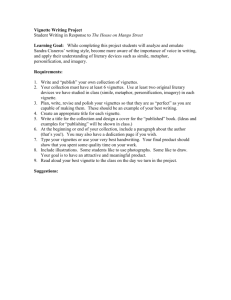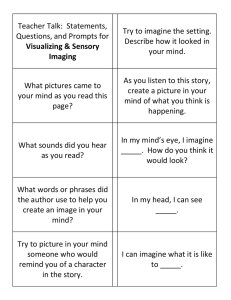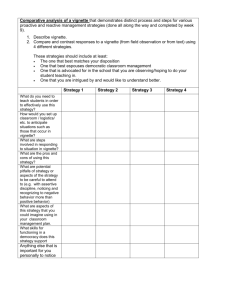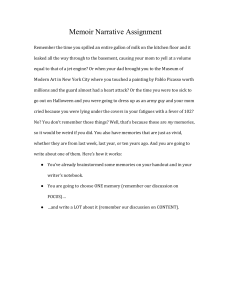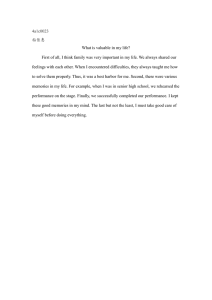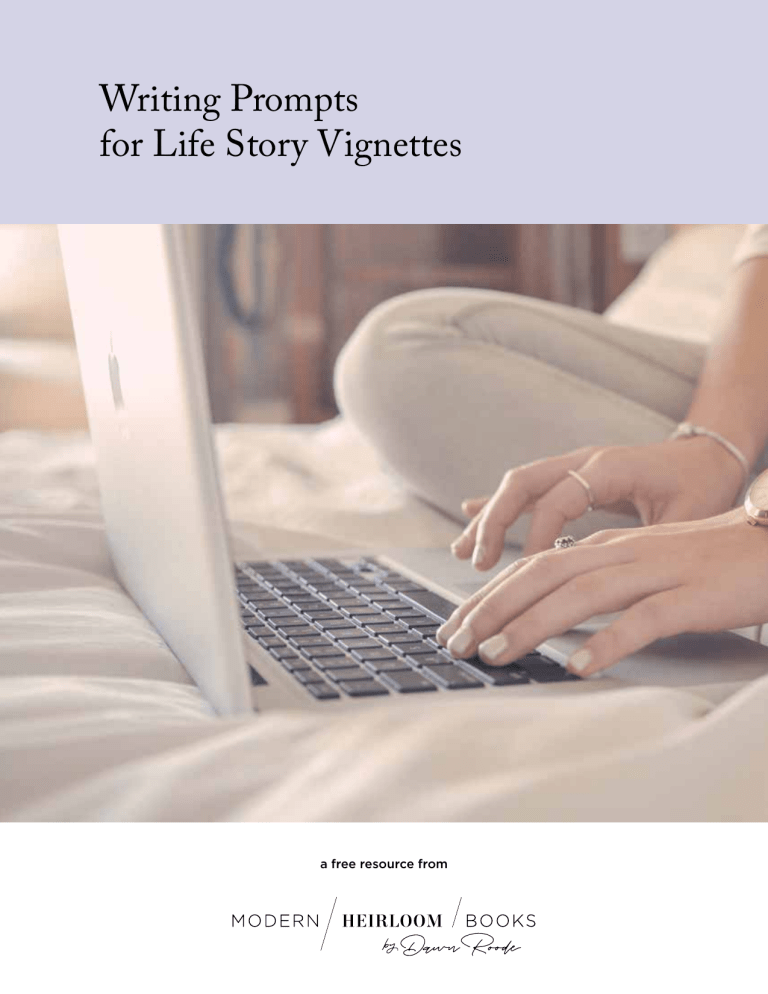
Writing Prompts for Life Story Vignettes a free resource from “The pages are still blank, but there is a miraculous feeling of the words being there, written in invisible ink and clamoring to become visible.” A vignette is a recollection of a memory or an episode from your life told evocatively. It is a snapshot of a moment. You may describe it in your own voice, or using dialogue reconstructed as best as your memory allows, using language to recreate your sensory experience—what did you smell, how was the light, what textures might you have touched? “Vignettes are tiny essays, story placards, postcards of injustice, single-image stories, little wisps of big ideas,” Tamara Pearson writes in Red Wedge Magazine. The best life story vignettes transport the reader to the scene, elicit feelings. There are two primary reasons that I encourage people (non-writers, particularly) to begin with a vignette: -vladimir nabokov 1 - It is a lot less intimidating to write one scene than “the story of your life.” And any writer will tell you: Just write. The words will not begin flowing unless you start. 2 - If you don’t have to worry about traditional story structure— beginning, middle, end; plot, conflict, resolution—the writing process becomes more straightforward. modernheirloombooks.com vignette vi·gnette \ vin-'yet, vēn \ a: a short descriptive literary sketch b: a brief incident or scene (as in a play or movie) When the daunting task of writing a major autobiographical work is broken into chunks, the writing becomes easier to manage. Guided prompts help rediscover lost memories. I recommend keeping a list of ideas in a notebook: Jot down memories that come to you unbidden, people you would like to recall, moments from your life you would like to revisit. Write phrases and visuals that may jog your memory later—Poppy’s red Cadillac, fishing at Johnny’s lake, the first time I wore red lipstick. 1 Allure of a stranger Be specific. Be sensual (the smell of the fish, if that comes to you; the tacky feel of the lipstick, perhaps). And when you need a little inspiration beyond your list of memories, try using one of the following prompts designed to get the memories—and your words—flowing. memory and watch “At best, what we can do is listen to ed, as well—who memory (the other senses are involv te, a fragrance, a touch?) hasn’t been transported back by a tas nt to reach our readers.” wa we se tho for ry mo me ate nsl tra d an –bill roorbach, writing life stories VIGNETTE WRITING EXERCISES Go somewhere you can people watch: the mall, a park, the library. Sit in silence and watch. What do you see? Does someone catch your attention? Think: What is it about this person that ... ... seems familiar? ... scares you? ... moves you? ... feels trustworthy? Imagine yourself sitting down comfortably with this individual over coffee. You can ask one question which leads them to share a story from their past—but you must answer the same question for them. Write: Imagine yourself speaking directly to this individual, sharing your story and perhaps your reason for sharing and how it makes you feel (is it something you have never told anyone before? that scares you? that makes you proud? joyful?). Sensory Prompts: 5 exercises for tapping all the senses to create a scene that resonates deeply 300 Words in 30 Minutes: 3 prompts for getting out the gate quickly—and for tackling a second draft Self Interview: An inspired way to approach answering tough questions about your life sensory prompts 3 2 Power of music Listen to your favorite album or song. Immerse yourself in it, avoiding other distracting activities while listening. Write: Where does the music take you? Are you transported to a different time or place? Describe the scene, how you feel. How do different songs connect to different parts of your life? 4 A room with you Show & tale Think of a room where you spent a lot of time as a child, a teenager, or even recently as an adult. Nothing monumental need have happened here; it is simply a place you have stayed, often. Think about the room: What do you see? Smell? Feel? Is there an object you touch? Is there someone with you—or in the next room? Choose an object from your life and write about it. Of course, what you choose will determine the course of your storytelling. Write: Describe this place in as much vivid detail as you can. Be specific, using all of your senses. Continue to explore who you were while in this place: Why were you there? Did you want to be there or someplace else? How did you feel? Would you return there if you could? If you have chosen the right location, your writing will develop from external setting to a sense of internal place. Think inside the box: • a piece of jewelry • s omething from your kitchen • a talisman/lucky charm • a trophy • your camera • a handwritten recipe …and outside the box: • a tattoo • your curly hair • an old car • a tree from your childhood yard Write: Imagine yourself touching the object, and describe that sensory experience. Tell the story of your object, weaving yourself into the story and finding the meaning and significance of the role this object has played in your life or a loved one’s life. Taste of the past 5 Think of a time when someone you loved cooked for you. Perhaps it was a holiday gathering, or more likely it was an ordinary day—cookies during afterschool homework, say, or breakfast before a road trip. Close your eyes and try to conjure the smells and tastes of the food, and use them as a gateway into your memories. Write: Start not with the food, but with your loved one, and describe the scene: the cooking, the discussion, the background noise and plans for the day. What was your loved one wearing? How did they make you feel? Were you aware that the act of cooking for you was an act of love? Have you made this food for someone? modernheirloombooks.com too short? If your vignette is shorter than 300 words, add to your story (by fleshing out details or drawing emotional conclusions) until it reaches this goal. too long? timed exercise If your vignette is longer than 300 words, edit the story down, aiming for a brevity that is crisply focused and conveys some essential truth. set a timer for 30 minutes Begin writing on one of these topics: Create a literary snapshot of someone close to you: a parent, friend, teacher, someone you love… Think of a turning point in your life and imagine you had made a different choice (not going to college, telling your secret, becoming a parent)… Write a vignette about an old family photograph in which you are pictured. What is the story of the moment in time captured in the photo—and what is just beyond the frame? What happened just after it was taken? wait... Let your vignette sit for at least four days to give you some distance. Reread it. 300 words in 30 minutes ...always Try to include striking images that give readers a strong sense of what you see, hear, and feel about your subject. modernheirloombooks.com + a few more tips For all the writing exercises recommended in this booklet, keep the following tips in mind and let your creativity flow! “Nice to meet you.” An oft-recommended exercise for first-time novelists is to “interview” their main characters: Imagine these fictional beings sitting before you, answering a list of questions of your making. By getting to know them, the thinking goes, the writer will be able to flesh out multi-dimensional characters with back-story, quirks and all. Well, you are the main character of any memoir writing you take on. You know yourself, of course, but it’s a rare soul who sees himself objectively, or who looks upon herself with clear eyes. So imagine you have been invited to sit across from Barbara Walters. You’re in a cushiony chair, glass of water within reach, ready to take on the tough questions. Ms. Walters, as you presumably know, is well known for making her guests cry, laugh, and gush as they open up about things they rarely if ever have discussed. This is one occasion where I will not be offering up suggestions for questions! You must play the role of interviewer and interviewee here. • Be sure to ask the tough questions. • Ask follow-ups! • Probe beyond one-word answers. • Be thorough, asking questions about your past, present, and future. • Think about what you wish people knew about you—and consider answering those questions you wish people perhaps didn’t know, too. Open yourself up to the possibilities. self interview Don’t worry about story structure and especially, don’t think about the BOOK. Simply think about your memories. “Show, don’t tell” does not mean stuffing your prose with adjectives and flowery descriptions. It does mean picking key sensory details to communicate the mood or emotion you’re after. Find your voice and use it. Don’t try to sound like someone else, and don’t overpolish your prose. Anyone lucky enough to read your stories down the line will be most charmed and touched knowing the real you. Keep reading! My spirit is continually replenished by the stories I read, and I become reinvigorated to write my own. Make writing a habit. Whether through a handwritten bullet journal, a digital diary, or regular writing prompt “homework,” do tell your stories! Never doubt that your story matters. It does, and sharing it is a gift. ber, Remem eds ne no one this to read . .. but you modernheirloombooks.com 1 finding inspiration in fiction Sandra Cisneros’s The House on Mango Street (1984) is a great fictional model for this kind of writing. The book is a series of sketches and vignettes written in rich, poetic prose that together form a loose narrative about the author’s Chicano childhood. The vignettes add up, as Cisneros has written, “to tell one big story, each story contributing to the whole—like beads in a necklace.” Told in first person, the book reads like a true autobiographical exploration. Her language is lush and figurative, offering us a glimpse into her world without much editorial exposition. 2 discovering voice Robert Fulghum, whose eight nonfiction books all rose to the top of the New York Times Bestseller List, refers to his writing as “stories, observations, and affirmations.” His books are filled with anecdotes, wit, and wisdom around everyday experiences and life-changing transitions. He says his “writing usually begins as journal entries—notes to myself—lines of verbal perspectives drawn from walking around and stopping at intersections as I move camp each year.” Fulghum says he molds his raw ideas into stories by sharing them aloud with a walking companion, thereby “editing” his stories as he goes. “In time, the stories and reflections migrate into book form,” he writes. “Even so, please keep in mind that I think of what I’m doing as writing letters and postcards to friends, always ending with the unspoken tag line: ‘Wish you were here.’” A few of Fulghum's titles to check out for inspiration for using a casual voice to capture vignettes that resonate: What on Earth Have I Done? (2007), It Was on Fire When I Lay Down on It (1989), and his classic All I Really Need to Know I Learned in Kindergarten (1986). inspirational reading modernheirloombooks.com more book suggestions 3 Reading memoir in the format in which you would like to write is an effective way to internalize style and discover what may and may not work for you. Here are a few additional titles that, in my opinion, utilize vignette-style writing to its fullest potential. The Abundance: Narrative Essays Old and New (2016) by Annie Dillard: The entry titled “Jokes” is a fine example of writing from family experience that feels particular and universal at the same time; even without a true narrative arc, Dillard develops her parents into real characters and paints a picture of her home that makes the reader feel a welcome guest. Tell Me More (2018) by Kelly Corrigan: Read this joy-filled, sensitive memoir not because it is vignette-driven (it is not) but because it very likely started out that way. Corrigan—who has been called “the voice of her generation” by O: The Oprah Magazine and “the poet laureate of the ordinary” by HuffPost— beautifully weaves 12 stories together to create a book that says plenty about her life, and ours. Consider Corrigan’s book a goal to strive for in terms of using life experience to convey something beyond yourself, and of editing stories so they transform into a whole that is greater than its parts. My First New York: Early Adventures in the Big City (2010) from the editors of New York magazine: This compendium of candid accounts from various luminaries puts New York City on the map in an entirely new and wholly personal way. Each vignette (called “small, glittering essays” by the LA Times) is an exquisite example of capturing a slice of life via an interview (translated for the book into as-told-to pieces), an approach anyone can try simply by speaking into your phone’s voice recorder and transcribing—and editing—later. I Remember (1975) by Joe Brainard: Dani Shapiro introduced me to this tiny gem during a memoir writing workshop a few years back, and I have recommended it countless times since. Brainard’s memories, recounted in a stream-of-consciousness fashion, are short and pointed, often mere phrases or single sentences, occasionally a brief paragraph, each beginning “I remember...”. Read this book to discover the power of short reminiscence, and emulate it to create your own list of prompts for future development. Meyer Berger of The New York Times has been described as a master of the short human interest story. According to The Poynter Institute, just before Berger's death in 1959, he wrote a story, approximately 1,200 words, on an old, poor, blind man who was once a classical musician. Then he wrote a sequel: E ight violins were offered the other day to Laurence Stroetz, the 82-year-old, cataract- the power of brevity blinded violinist who was taken to St. Clare’s Hospital on East Seventy-first Street from a Bowery flophouse. The offers came from men and women who had read that though he had once played with the Pittsburgh Symphony Orchestra, he had been without a violin for more than 30 years. The first instrument to reach the hospital was a gift from the Lighthouse, the institution for the sightless. It was delivered by a blind man. A nun took it to the octogenarian. He played it a while, tenderly and softly, then gave it back. He said: ‘This is a fine old violin. Tell the owner to take good care of it.’ The white-clad nun said: ‘It is your violin, Mr. Stroetz. It is a gift.’ The old man bent his head over it. He wept. In just 145 words, Berger enlivens “the 82-year-old, cataract blinded violinist” and we are left with an impression of a man, and a moment, brimming with human emotions. Keep learning. Want to continue your journey of writing your life? Visit our blog for more tips, including: Unexpected places to discover great life story questions • Books to help you write your family’s stories, even if you are not a writer • How to choose the best pictures to use as writing prompts • Family history questions for personal history interviews over Thanksgiving & Christmas Hire us. Whether you are midway through your memoir, are just beginning to write a few personal vignettes, or would prefer to have your stories captured during a series of personal history interviews, we can help. Set up a free consultation to learn how we can work together. Call MHB founder Dawn 917.922.7415 or email dawn@ modernheirloombooks .com modernheirloombooks .com/new-blog next steps Make memories! Thank you for embarking on a journey of life story writing & memory preservation with us! Our Story Modern Heirloom Books, founded by magazine publishing veteran Dawn M. Roode (Vogue, Vanity Fair, Harper's Bazaar, Parenting), is the best resource for helping you preserve and share your stories exquisitely. We expertly curate your “stuff ”— old photos from boxes, digital family photos from phones and hard drives; hone your memories; elicit stories that surprise and delight; and design a coffee table book that is graphically and narratively evocative. @heirloombooks Dawn’s compassionate and interested interviewing style makes subjects not @modernheirloom only feel comfortable, but excited about sharing their stories. /modernheirloombooks VISIT SITE FOR DETAILS modernheirloombooks.com
